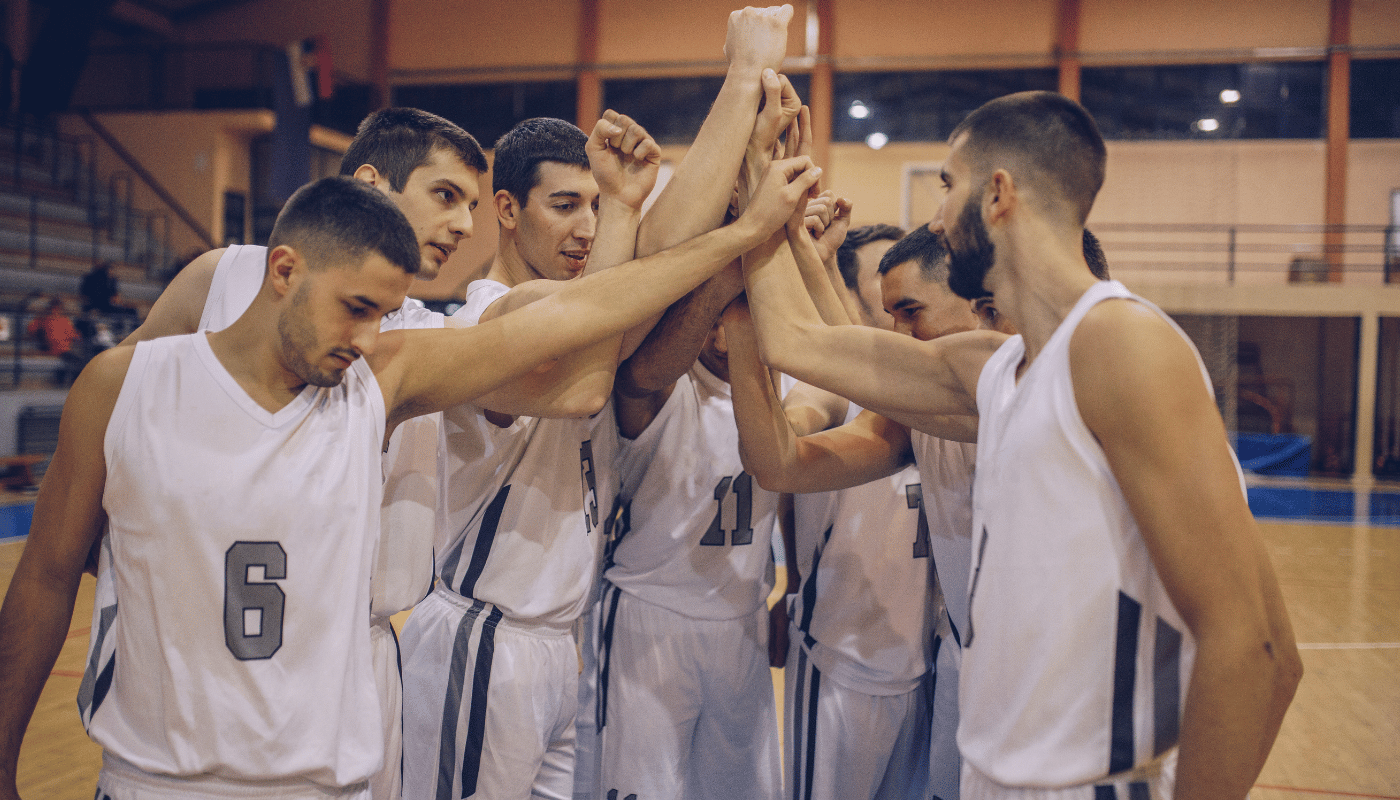When talking about basketball, a common question is: How many players are on a basketball team, including substitutes? Knowing how teams are set up, with both active players and substitutes, is important for fans, players, and coaches. This article explains how basketball rosters work and looks at the rules and roles of players at different levels of the game.
Understanding Basketball Team Structure
To answer how many players are on a basketball team, including substitutes, we need to understand how a basketball team is organized. A team has core players who start the game and substitutes who can come into the game to replace others. Both starters and substitutes are important for a team’s success.
Having a good team structure matters a lot. A team that works well together often does better than one with just talented individuals. Every player, whether they start or come off the bench, contributes to how well the team plays. Teamwork, strategy, and coordination are key elements that determine a team’s performance on the court.
Team Composition
Most basketball teams have a starting lineup and a group of substitutes. The starting lineup usually has five players who begin the game. The coach chooses these players based on their skills, how well they play together, and the strategy for the game. Factors like experience, teamwork, and specific skills play a role in selecting starters.
Substitutes are other team members who can replace starters during the game. They help keep players fresh and can change the flow of the game when needed. Substitutes are key for managing fatigue and adjusting strategies during the game. Coaches use substitutes to respond to the opponent’s tactics or to give their team an advantage.
Typical Player Count in Basketball
In professional and college basketball, teams usually have 12 to 15 players on their roster. This includes both starters and substitutes. However, not all players may play in every game. The number of players who can be active for a game can vary by league.
In the NBA, teams can have up to 15 players, but only 13 can be active for a game. This means two players are inactive and cannot play in that game. Coaches decide who will be active based on strategy, injuries, and player performance.
Standard Roster Sizes in Different Leagues
- NBA: Teams have up to 15 players on the roster, with 13 active for each game.
- NCAA College Basketball: No strict limit on roster size, but teams typically have around 15 players.
- FIBA International Play: Teams can have up to 12 players for tournaments.
- High School Basketball: Teams usually have 12 to 15 players.
- Youth Leagues: Roster sizes can vary widely, often depending on the number of participants.
Positions on a Basketball Team
Each player on a basketball team has a specific position, which defines their role on the court. There are five main positions, each with unique responsibilities:
- Point Guard (PG): Often the team’s best ball handler and passer. They run the offense and make decisions about where the ball goes. The point guard is like the team’s quarterback, directing plays and setting the pace.
- Shooting Guard (SG): Typically a strong shooter, especially from long range. They often score points by shooting from outside the three-point line. The shooting guard also helps handle the ball and can drive to the basket.
- Small Forward (SF): Versatile players who can score from inside and outside. They need to be good at multiple skills, including shooting, dribbling, and defense. Small forwards often guard the opponent’s best offensive players.
- Power Forward (PF): Usually strong players who play near the basket, grabbing rebounds and scoring close to the hoop. They play physically, setting screens, and defending against the other team’s big players.
- Center (C): Usually the tallest player, who plays near the basket, blocks shots, and rebounds. The center defends the rim and often scores from close range. They play a key role in both offense and defense.
These positions help organize the team’s strategy on offense and defense. Players may sometimes play multiple positions, depending on their skills and the team’s needs.
The Role of Substitutes
Substitutes are important because they allow teams to keep players fresh and adapt to different situations in the game. Basketball is fast-paced, and players can get tired quickly. Substitutes come in to give starters a rest and can bring new energy to the game.
Players run a lot during a basketball game, so they need rest to perform their best. Coaches use substitutes to manage fatigue, ensuring players don’t get too tired and can avoid injuries. By rotating players, teams can maintain a high level of energy throughout the game.
For example, a coach might substitute players every few minutes to keep everyone fresh. This is especially important in professional leagues where the game is very fast and intense.
Coaches also use substitutes to make strategic changes during the game. For example, if the other team has a tall player who is scoring a lot, the coach might substitute a stronger defender to stop them. Substitutes can change the pace and style of the game.
If a team needs more scoring, the coach might bring in a player who is a good shooter. If they need better defense, they might substitute in a player known for their defensive skills. This flexibility helps teams respond to different situations during the game.
Official Rules and Regulations
Different leagues have rules about how many players can be on a team and how substitutions work. Understanding these rules helps answer how many players are on a basketball team, including substitutes.
Comparison of Roster Sizes and Substitution Rules
| League | Max Roster Size | Active Players Per Game | Substitution Rules |
| NBA | 15 | 13 | Unlimited substitutions during stoppages |
| NCAA College Basketball | No set limit | Usually 15 | Unlimited substitutions during stoppages |
| FIBA | 12 | 12 | Unlimited substitutions during stoppages |
| High School Basketball | Varies | Usually 12-15 | Unlimited substitutions during stoppages |
| Youth Leagues | Varies | Varies | May have rules to ensure equal playing time |
Variations Across Different Leagues
Different leagues have different rules about team sizes and substitutions. In the NBA, teams have up to 15 players, but only 13 can be active for a game. In college basketball, there is no strict limit on roster size, but teams usually have around 15 players. International competitions under FIBA allow 12 players per team.
In youth leagues, rosters can be smaller or larger, depending on how many kids are participating. These leagues often focus on giving everyone a chance to play and learn the game. Some youth leagues have rules to ensure that all players get playing time, which helps with development and enjoyment of the game.
Youth Basketball Teams
In youth basketball, the number of players on a team can vary widely. Some teams might have as few as 8 players, while others might have more than 15. Coaches in youth leagues often focus on teaching the basics of the game and ensuring that all players get a chance to play.
Having more players can be challenging because it means less playing time for each child. Coaches must balance the desire to win with the need to develop all players. This often involves rotating players frequently and giving everyone an opportunity to play different positions.
International Play and FIBA Rules
In international competitions governed by FIBA (International Basketball Federation), teams are allowed a maximum of 12 players. All 12 players can be active and play in the games. The substitution rules are similar to other leagues, allowing coaches to substitute players during stoppages.
International play often has slight differences in rules compared to the NBA, such as court dimensions and the distance of the three-point line. Players and coaches must adapt to these differences when competing internationally.
Factors Influencing Roster Sizes
Several things affect how big a basketball team’s roster is:
- League Rules: Different leagues have different rules about how many players can be on a team.
- Budget and Resources: Professional teams with more money can afford to have more players. Amateur teams may have limited resources.
- Coaching Philosophy: Some coaches prefer smaller rosters to focus on a core group of players, while others like larger rosters for more options.
- Player Development: Teams may carry extra players to develop their skills for the future.
- Injuries: Teams may keep more players on the roster to be prepared for injuries.
Team Budget and Resources
In professional leagues, teams have budgets that affect how many players they can sign. Teams need to pay player salaries, so they must balance having enough players with staying within their budget. In some leagues, there are salary caps that limit how much teams can spend on player salaries.
In amateur and youth leagues, resources can be limited. Teams may not have the funds to support large rosters, or they may have to share facilities and equipment. Coaches and organizers have to make decisions based on what is available.
Coaching Philosophy
A coach’s approach can influence how many players are on the team and how they are used. Some coaches prefer to have a tight rotation, using a small group of players for most of the game. Others like to use many players to keep everyone involved and maintain high energy levels.
Coaches also decide how to develop players. In youth basketball, coaches might focus on giving everyone equal playing time to help them improve. In professional basketball, coaches might focus more on winning games and use their best players more often.
The Impact of Injuries on Roster Composition
Injuries are a part of sports, and they can affect how teams manage their rosters. If a player gets injured, the team needs to have substitutes who can fill in. Teams might keep extra players on the roster to be prepared for injuries.
Emergency Substitutions
If a player is injured during a game, the coach must substitute another player. Having versatile substitutes who can play multiple positions helps the team adapt to unexpected situations. This is why depth in the roster is important.
Depth Charts and Player Development
Teams use depth charts to organize their players by position and rank. This helps coaches know who is available to substitute in each position. Developing players who can step up when needed is crucial for a team’s success.
In professional leagues, teams might have development squads or assign players to minor leagues to gain experience. In college and high school, younger players can develop over time and move into bigger roles as they improve.
Importance of Understanding Team Sizes
Knowing how many players are on a basketball team, including substitutes, helps fans understand the game better. It also helps players know their roles and coaches to plan strategies.
For players, understanding their role on the team helps them focus on what they need to improve. For coaches, managing the roster effectively can be the difference between winning and losing games.
Conclusion
In basketball, teams are made up of starters and substitutes who all play important roles. While five players are on the court at a time, teams usually have 12 to 15 players to manage fatigue, injuries, and strategy changes. Understanding the team structure, positions, and league rules gives a clearer picture of how basketball teams work.
Whether you’re a fan, player, or coach, knowing these details can enhance your appreciation of the game. Basketball is a team sport that relies on the contributions of all its players, from the starters to the substitutes. Each player’s role is important in the team’s overall success.



